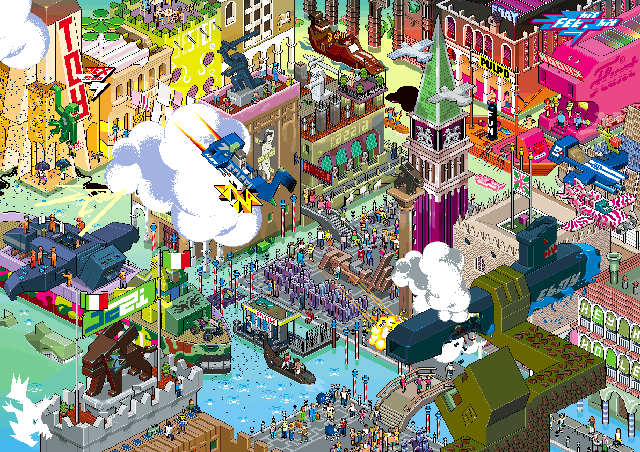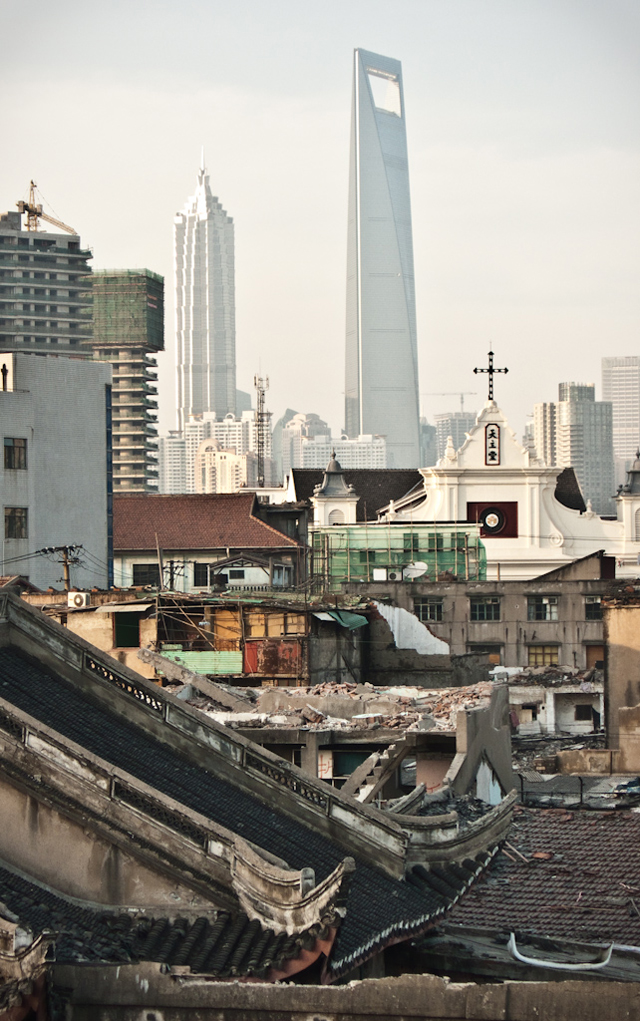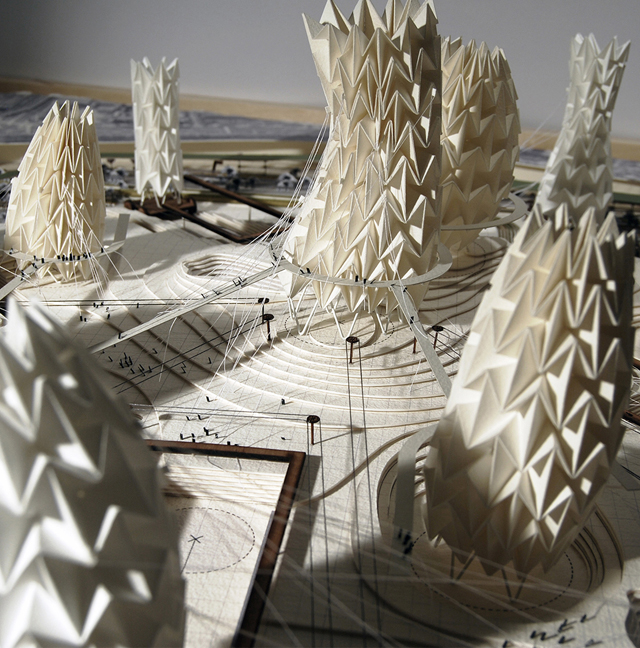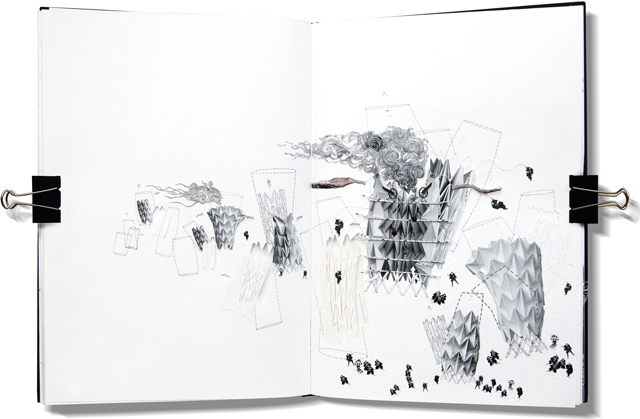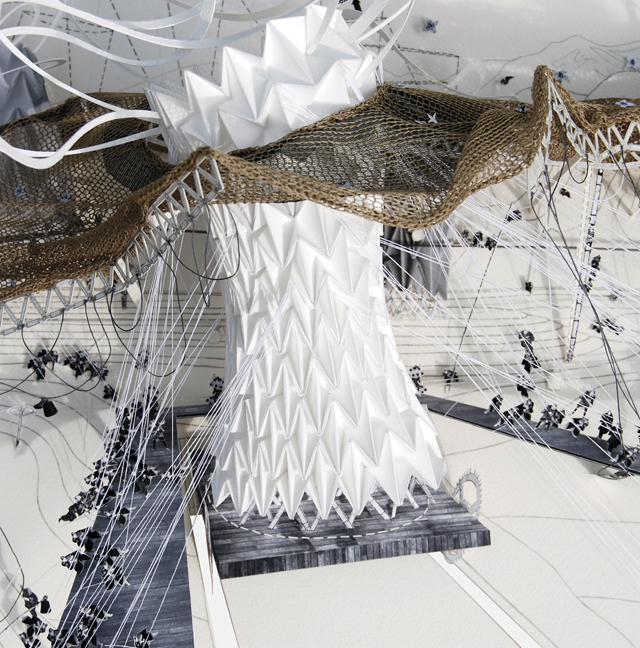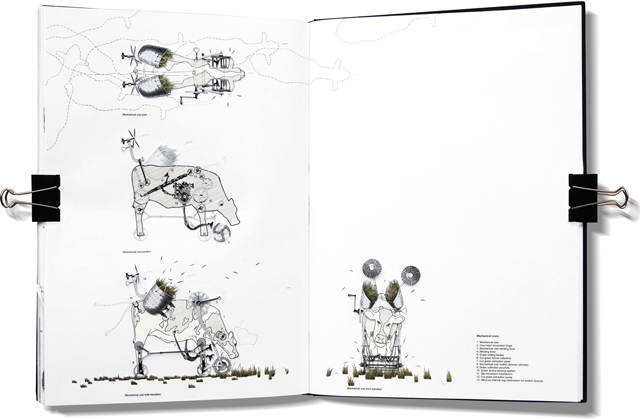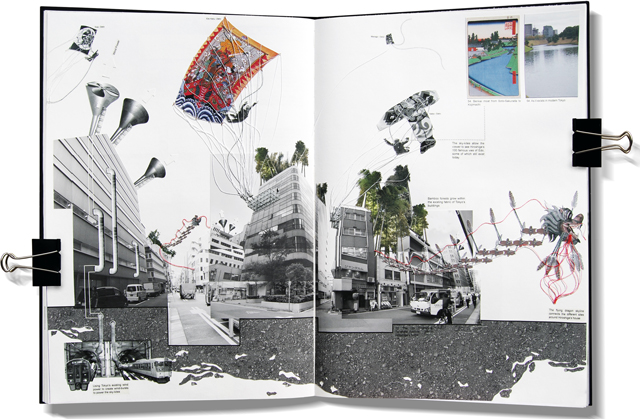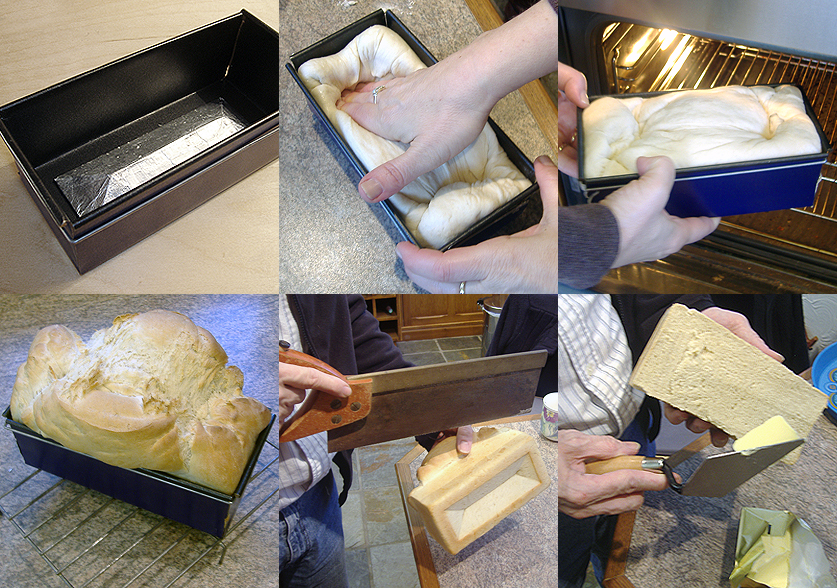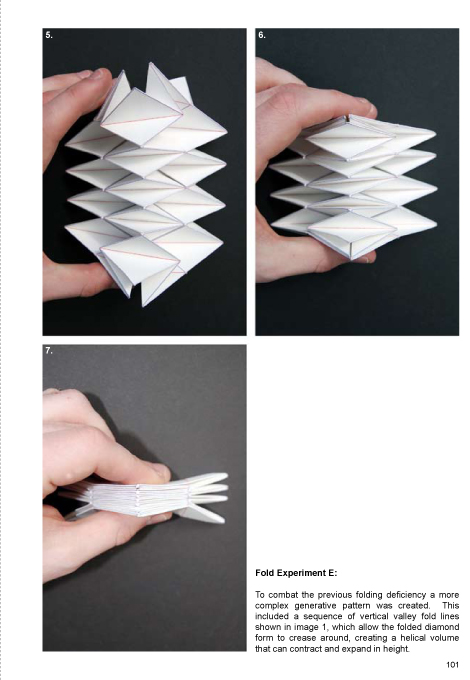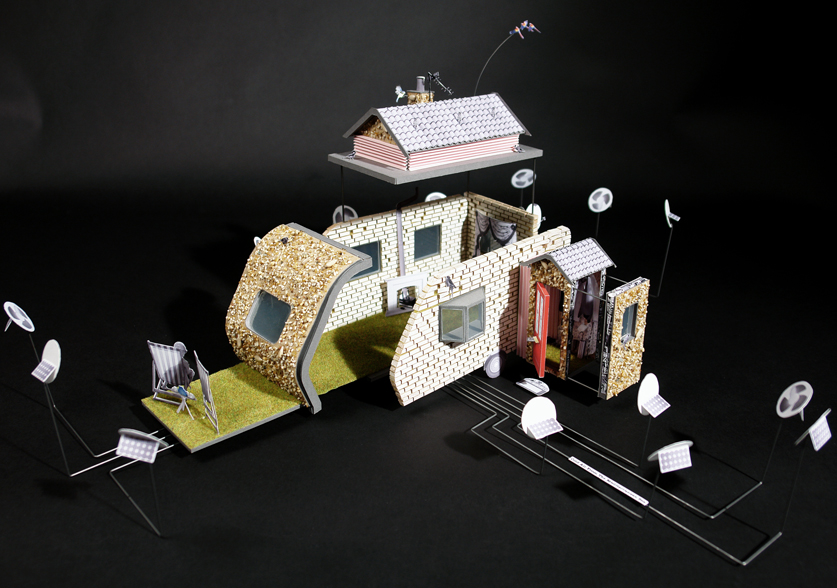THOMAS HILLIER – THE ARCHITECT OF ATMOSPHERE
Make yourself comfortable if you’re not.Crop a five-minute break; if you are at work, university or on the street,on a bed of asphalt, making large puffs of heat.In the last case perhaps it’s better for you to get in the shade before you continue reading…
However, this is the right time for a break and,if there is need,to give a new direction to the day.First of all you will make a jump to Mel and Judith’s, a retired couple of sprightly Londoners, enjoying the lavish Egyptian beach, then you will listen to the sad and compelling story of the weaving Princess and the Cowherd, and if it’s not enough you can always ask the author a few questions about the characters,the architect/narrator/artisan Thomas Hillier. The work of Thomas requires: the reading of his sketches, observation, and finally in its plastic construction, has the mysterious power that lies behind each well done piece: imagination, passion, humor, patience and instinct. The space takes shape beginning from the history of individual characters, who are no longer the pretext of a narrative, but the real fulcrum. With a bit of imagination we can immerse ourselves in his products, go back in time and see him glue Mel and Judith comfortably to their plane seats, a smiling hostess in the central corridor, window on the panorama (sky and the Bay of Biscay), a bun pinned on a pin, then post-its and planes flying here and there …the objects immersed in the scene, the techniques used and the construction technologies represented, are all narrative devices, the plot of a story that allows the architecture to emerge as a narrative. Like any good writer Thomas also utilizes effective techniques, does not try to force the audience to wonder,using basic and low cost tools: paper, pen, pencil, colors and found objects, returning to the project sustainability, in the ideas and form,not only in the aesthetic impact.
It is impossible not to accost the work of Hillier to the works of the great historical avant-garde artists, Rodchenko’s collages and perhaps the most audace of Moholy-Nagy. This last, if he could observe his work would certainly have repeated the famous phrase:”We need to replace the static principle of classical art with the dynamics of universal life.” Thomas concentrates on this with all his heart, life.
The protagonists of his environments, whether it’s in the sunny Luxor of Mel and Judith or in the Tokyo of “The Emperor’s Castle”, left over clippings of themselves, make and engrave, with discretion, the places they live in their presence. And suddenly here is that nostalgia that pushes Mel and Judith to cover the interior of their caravan with the aroma of their beloved English bread or transform the bathroom into a beer fermentation laboratory and if the sand of the beach is too hot, there is always the fresh grass as the floor of the caravan.
Just like the cliché of the dog that looks like his master, in front of such irony, one wonders which of the two, the environment or inhabitant, reflects the character of the other. In “The Emperor’s Castle,” the Princess is transformed into an architectural metaphor, a diaphanous mebrana of woven materials, that in trying to reach the lover (represented by grazing at the edge of site) is spreading like a lung, incorporating the surrounding tissue and converting the urban environment in a real theater.
It is clear then after careful observation, how Hillier is able to make out of waste of rationality and intuitions a precise and detailed map, which indicates no guidance or reference points, but excites and nourishes our curiosity, and it seems to simply suggest: be cautious because there is something new out there, made up of ideas just waiting to be cut,pasted, and rearranged.
Federico Giacomarra: In your ideas the technical issue gives back an intense poetic load, what’s the difference between the technical issue and the narrative one?
Thomas Hillier: Of course the technical issues, especially within an architectural project are important but in my work I use them to slowly inform the narrative of the design as it progresses, shaping the final outcome rather than applying a technical solution to a design problem. So for example with ‘The Migration of Mel & Judith’ I spent a lot of time researching the process of making beer and bread and their inherent link to one another. This also led to some nice surprises such as the by-product of these processes which can be used to attract algae and thus fish, perfect for Mel, a keen fisherman. I used these processes as a way creating the story of the couple’s relationship with not only each other but also the building.
The Emperors Castle took a much more in depth look at using innovative and poetic materials coupled with a technological understanding to help drive the project. This culminated in a 15,000-word thesis exploring the fabrication of two major architectural themes, the Emperor’s Origami Lungs and the Princess’s Knitted Canopy. The origami lungs were not only based on geometrical tessellating crease patterns which I adopted from the art of origami but also the medical profession. The lungs take clues from artificial tubes inserted into the body called ‘stents’ which expand to increase blood flow. The profession is currently adopting origami to create a tube that can expand and contract from an incredibly small to a large scale. For the knitted skin I taught myself to knit using a variety of different stitch methods and materials to explore how this flexible skin would react to environmental conditions such as sunlight and rainfall.
The ‘making’ and ‘experimenting’ process informed and became intrinsically linked within the project outcomes. This tactility, although imaginary used elements researched in reality, giving the work a more intellectual weight, answering some of the more architectural questions posed.
Federico Giacomarra: What are your references in architecture history?
Thomas Hillier: That’s a good question that I always find hard to answer from an architectural perspective, as, honestly most of my references are almost always non-architectural but they always have a spatial quality to them. The Migration of Mel and Judith was partly inspired by my personal experiences growing up in a small rural town in the South of England. Experiences such as small town social attitudes, English home comforts, living off the land and a do-it-yourself mentality. Other inspirations include an early Thom Mayne (Morphosis) project called Sixth Street House, the artist Joan Livingstone, one of my favourite artists Heath Robinson and the inflatable aeroponic systems designed by NASA. Finally and possibly most importantly is the film by Hayao Miyazaki called Howls Moving Castle, a film with a castle made of bizarre components that could walk!
The Emperor’s Castle was full of references both architectural and obscure. Architecturally the Segrada Familia was a key reference to the origami lungs. I wanted the lungs to feel as vast, expansive and awe-inspiring as Segrada Familia did the first time I went inside. I also referenced and researched Japanese ‘Minka’ Folkhouses and the amazing self-fashioned floating islands in Lake Titicaca constructed by the Uros from dried totora reeds. Of course Japanese culture was key to the project, Kabuki theatre, kite photography and artists such as Ando Hiroshige, Hokusai and Yamaguchi Akira were all inspirations. Again another film was particularly inspiring called ‘Strings’ the only full-length feature film using marionettes, catch It if you can its visually stunning!
Federico Giacomarra: What are the steps of your creative process? How long did it take from the idea to realization?
Thomas Hillier: Of course with each project the process evolves, which I think is one of the most exciting aspects of this narrative form of architecture, similar to how a story can change with every line written. Fiction allows the architect to represent ideas both physically and metaphorically, defying logical reason in unpredictable ways, providing an escape from the prosaic within architecture and urban planning. This notion has continued to open new territories in depiction and expression, both ‘The Emperor’s Castle’ and ‘The Migration of Mel & Judith’ use a fictional narrative as the driving force for both the architectural proposition and its form of representation, illustrating the porosity between fact and fiction.
Both projects mentioned above began with many months of research into quite broad subjects such as migration and Japanese art. With ‘The Emperor’s Castle’ I illustrated elements of this research within my “research storybooks” which began to explore the narrative structure of the tale, creating a series o f ‘clues’ which helped inform the future architectural propositions for the project. The fairytale narrative was the stimulus to produce this exploratory stage in a sketchbook format. These hand-cut, stitched, sewn and drawn assemblages were ‘cut’ directly onto the blank sheets of the sketchbook creating a universe in two and a half dimensions. The books allow the reader to become part of the architecture as it progresses, liberating them from architectural reality. The final triptych for ‘The Emperor’s Castle’ combined all the elements from the “research storybooks” into one piece. This began with sketches produced at 1:1 that allowed me to loosely devise and ‘plan-out’ this large piece which measures just under two metres in length. These sketches informed the level of depth and perspective I wished to create along with compositional qualities. When this was complete I collated a library of imagery that would be inserted into the piece, images of which were used in the production of the previous pieces. These images were collected throughout the project and were sourced predominantly from photographs, Japanese books and image encyclopedias. Once these images were sourced and located on the 1:1 sketches they were printed in preparation to be cut and collaged. Although with my collage the rules of perspective don’t always apply, the triptych employed a variety of varying depths of perspective and scale across its length. The advantage of collage as a technique of representation is its unpredictable and visceral nature. No matter how much preparation is undertaken as soon as cut paper is put to page the work evolves and takes on a life of its own. It is here where the imagination and creativity of the architect/artist is at its most potent. Unlike computational based architecture that can create a human detachment from a building designed on screen, collage, as with drawing is a more intuitive and a natural process between brain and hand, allowing the drawing to adapt as the piece develops. The timeline of this process varies dependant on the project, The Emperors Castle, my most complete and researched project to date took approximately 8 months from start to finish.ù
Federico Giacomarra: How are Mel and Judith? Are they still in Luxor?
Thomas Hillier: They are still happily living on their English island in the middle of the Nile, although Mel is starting to get a bit bored of fishing! Since they have made a good profit from renting out their rose-chalets and selling beer to the English tourists they have just booked a flight back to England to see their daughter Polly. Polly, their eldest daughter is a taxidermy artist who lives in a giant birdcage with a keen bird-watcher and a rather mad bird-hunter. Polly and her fellow housemates have formed a symbiotic relationship with another allowing them all to gain from their interactions within this weird and wonderful birdcage menagerie. Polly’s house will be the next chapter in Mel & Judith’s story that I have began writing and I will embark on fully as soon as I have completed exploring ‘The Emperor’s Castle’ outside of the sketchbooks. For this I am currently in the process of translating the assemblages from these sketchbooks into individual, larger and more fantastical pieces with the hope to have both an exhibition and publication in the near future.
Related Posts :
Category: Editorial
Views: 11202 Likes: 3
Tags: interview , thomas hillier
Comments:
Info:
Info:
Title: THOMAS HILLIER – THE ARCHITECT OF ATMOSPHERE
Time: 3 novembre 2011
Category: Editorial
Views: 11202 Likes: 3
Tags: interview , thomas hillier

